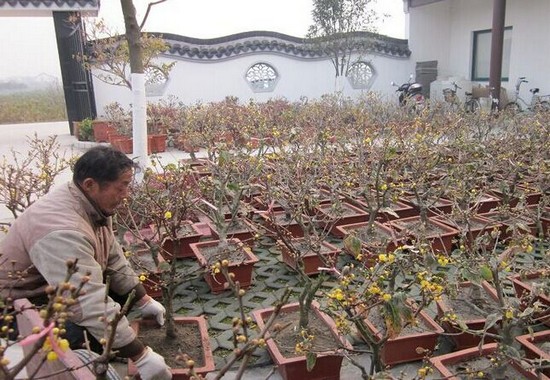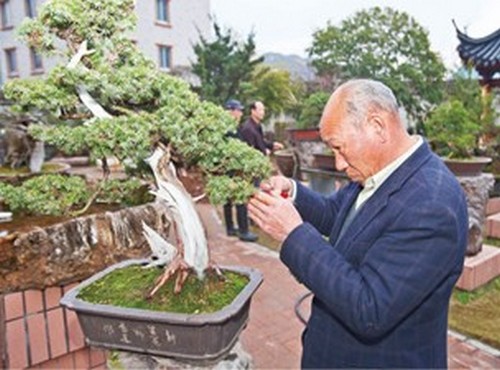Cultivation of Elm Bonsai
Ulmus pumila usually sows and propagates. From October to November, the seeds are ripe and the fruit wings are yellowish brown. They should be harvested in time, spread out and dried, sundries removed and stored in bags. Sowing, sowing or strip sowing in March of the following spring. The row spacing of strip sowing is 25 cm, sowing on a windless and sunny day, covered with fine soil, with no seeds for the degree, and then covered with straw. It can be germinated and unearthed in about 30 days, so the grass should be uncovered in time and the seedlings should be suitable. During the growth period, we should do a good job in water and fertilizer management, weed and loosen the soil, and the seedlings of the same year can be as high as 30cm and 40cm. Young tree seedlings have sparse dry twigs and large leaves, which are generally not suitable for making bonsai. They should be cultivated for several years. After pruning and shaping, it is better to go on the basin. In addition, Ulmus pumila can also be propagated by root cuttings to cultivate pile materials, which has a fast effect and is widely used in South China.

It takes at least 2 to 3 years for the old tree stump to be cultivated. A rapid culture method is introduced here, which is especially suitable for the growth of bonsai. The hammer elm stump dug back in early spring was first planted in a tile bowl, and after survival, the unwanted buds were picked at any time, and the posture began from the end of April to the beginning of May. When the branches grow to 15-18 cm long, use thin wire to climb and shape, and pay attention to maintenance and management. When sprouting new branches and growing 4-6 leaves, pruning can be carried out. Generally, only two leaves are left on each twig, and nitrogen fertilizer is applied immediately to promote the emergence of new buds on the new branches, so that the leaves can grow thickly as soon as possible. With the continuous thickening of branches, the wire must be removed in time to prevent "trapping". For the unshaped branches, they can be clamped up again to fix their shape. In this way, a pot of nut elm pile scene can be initially formed in September.
The key to this rapid prototyping method is mainly climbing when the xylem of the branch has not yet hardened, so the production should be made with special care, the thickness of the wire should also be selected properly, and the winding should not be too tight to prevent damage to the delicate branches. In addition, it is also necessary to do a good job of "raising embryos" in order to achieve the goal of digging piles for one year to make bonsai.
The old piles of elm trees that have just been excavated should be planted in plain sand or planted in tile pots to "raise piles". It is generally carried out from late autumn to spring (the survival rate is the highest in the two or three months before sprouting). Before planting, the roots and branches should be pruned first, and the viscous sap often flows out at the cut. If the liquid exudates too much, it will seriously affect the survival rate. Use paint, wax seal in the cut, you can also apply a layer of erythromycin ointment or sulfonamide ointment, and then sprinkle with fine sand. Compact the soil as much as possible after planting, but do not need to water, just spray clean water to the branches 1-2 times a day, and water again 3-4 days later. It is forbidden to accumulate water in the soil if it is not dry or watered in the future.
Secondly, according to the basic shape of the old pile, the elm bonsai should be made into different forms of bonsai, such as straight dry type, curved dry type, oblique dry type, water-facing type, cliff type, wind type, jungle type, stone-attached type and so on. Modeling time can be in the dormant period after falling leaves, but also in the growing period, but to avoid the budding period.
Time: 2019-06-12 Click:
- Prev

Teach you to cultivate wintersweet bonsai quickly.
Chimonanthus is a deciduous shrub with opposite leaves, rough leaves, and flowers on new branches (that is, annual branches) born in the axils of previous annual branches. The flowering period is from December to February, and the fruiting period is from August to September of the following year. Its adaptability is strong, drought resistance, cold resistance, like light, like fertilizer, not resistant to bituminous coal. Resistance to pruning
- Next

Modeling method of juniper bonsai
The so-called juniper shape, that is, through the production process of binding, tying, twisting, pinching, pulling, thinning, and shearing, a plain juniper is made into a vibrant shape, such as lion, tiger and other animals; pavilions, buildings, and other buildings; aircraft, rockets and other popular science shapes. These short ones are about feet, and the high ones are several meters high.
Related
- Fuxing push coffee new agricultural production and marketing class: lack of small-scale processing plants
- Jujube rice field leisure farm deep ploughing Yilan for five years to create a space for organic food and play
- Nongyu Farm-A trial of organic papaya for brave women with advanced technology
- Four points for attention in the prevention and control of diseases and insect pests of edible fungi
- How to add nutrient solution to Edible Fungi
- Is there any good way to control edible fungus mites?
- Open Inoculation Technology of Edible Fungi
- Is there any clever way to use fertilizer for edible fungus in winter?
- What agents are used to kill the pathogens of edible fungi in the mushroom shed?
- Rapid drying of Edible Fungi

